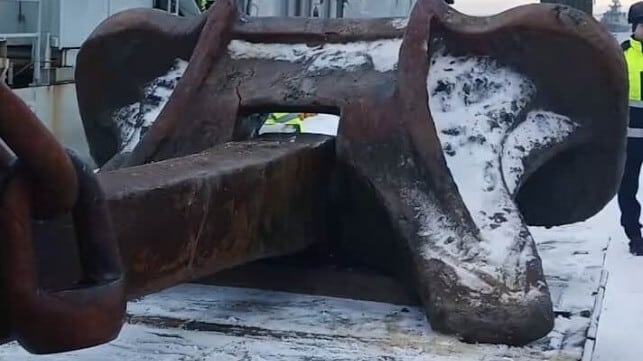Suspected Sabotage Ship’s Anchor Shows Signs of Extreme Damage

Authorities in Finland and Sweden have successfully recovered the lost anchor of the tanker Eagle S. This vessel is under scrutiny for allegedly severing four fiber-optic cables and a power cable in the Gulf of Finland on Christmas Day. The incident has raised significant concerns about maritime safety and the potential for intentional damage to critical infrastructure. The recovery operation, which took place near the Porkkala Peninsula, highlights the complexities involved in maritime navigation and the responsibilities of vessel crews.
Details of the Recovery Operation
On Sunday night, Finnish authorities, aided by the Swedish submarine rescue vessel HMS Belos, located the anchor at a depth of 80 meters off the Porkkala Peninsula. Detective Superintendent Risto Lohi from Finland’s National Bureau of Investigation (NBI) confirmed that the anchor was found along the route of the Eagle S, specifically at the western end of the drag trace on the seabed. This trace indicates the path the anchor took while being dragged, which is believed to have extended for about 50 nautical miles.
The recovery operation began promptly after the anchor’s location was confirmed. By Monday afternoon, the anchor was successfully raised to the surface. Images from the operation show the anchor exhibiting signs of severe damage, including a broken fluke and a large crack on its crown. These findings have led maritime security experts to suspect that the anchor-dragging incident was not an accident, but rather a deliberate act. The complexity of the maneuver required to drag an anchor under power suggests that it would be difficult to execute without intent.
Implications and Ongoing Investigations
The incident involving the Eagle S is not an isolated case. It marks the third occurrence of similar cable severing incidents in the Baltic Sea within the past 15 months, following incidents involving the Chinese vessels Newnew Polar Bear and Yi Peng 3. These repeated occurrences have raised alarms among maritime authorities and security experts. The Finnish authorities have detained the Eagle S for a criminal investigation and have issued travel bans to eight crew members suspected of involvement in the incident.
Experts believe that for the anchor to drag for such a long distance without the crew noticing, several critical safety protocols would have to be ignored. The crew would need to slow down, pay out the correct length of anchor chain, and secure it properly—all while navigating through busy sea lanes and near submarine cable crossings. The vibrations caused by dragging the anchor would likely have been significant, making it nearly impossible for the crew to remain unaware of the situation.
The ongoing investigation aims to determine the exact circumstances surrounding the incident and whether any criminal activity was involved. The implications of this investigation extend beyond the Eagle S, as it raises broader questions about maritime safety and the protection of critical infrastructure in the region. As authorities continue their inquiries, the maritime community remains vigilant about the potential risks posed by similar incidents in the future.
